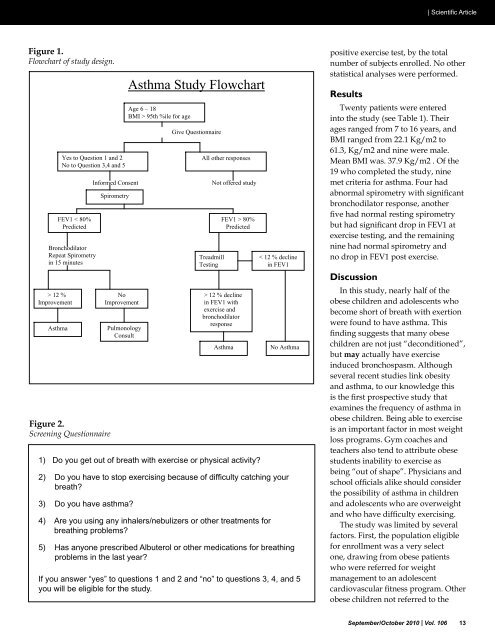September/October - West Virginia State Medical Association
September/October - West Virginia State Medical Association
September/October - West Virginia State Medical Association
You also want an ePaper? Increase the reach of your titles
YUMPU automatically turns print PDFs into web optimized ePapers that Google loves.
| Scientific Article<br />
Figure 1.<br />
Flowchart of study design.<br />
Figure1: Flowchart of study design.<br />
Bronchodilator<br />
Repeat Spirometry<br />
in 15 minutes<br />
> 12 %<br />
Improvement<br />
Yes to Question 1 and 2<br />
No to Question 3,4 and 5<br />
FEV1 < 80%<br />
Predicted<br />
Asthma<br />
Figure 2.<br />
Screening Questionnaire<br />
Informed Consent<br />
Spirometry<br />
No<br />
Improvement<br />
Pulmonology<br />
Consult<br />
Asthma Study Flowchart<br />
Age 6 – 18<br />
BMI > 95th %ile for age<br />
Give Questionnaire<br />
All other responses<br />
Treadmill<br />
Testing<br />
Not offered study<br />
FEV1 > 80%<br />
Predicted<br />
> 12 % decline<br />
in FEV1 with<br />
exercise and<br />
bronchodilator<br />
response<br />
Asthma<br />
1) Do you get out of breath with exercise or physical activity?<br />
10<br />
< 12 % decline<br />
in FEV1<br />
No Asthma<br />
2) Do you have to stop exercising because of difficulty catching your<br />
breath?<br />
3) Do you have asthma?<br />
4) Are you using any inhalers/nebulizers or other treatments for<br />
breathing problems?<br />
5) Has anyone prescribed Albuterol or other medications for breathing<br />
problems in the last year?<br />
If you answer “yes” to questions 1 and 2 and “no” to questions 3, 4, and 5<br />
you will be eligible for the study.<br />
positive exercise test, by the total<br />
number of subjects enrolled. No other<br />
statistical analyses were performed.<br />
Results<br />
Twenty patients were entered<br />
into the study (see Table 1). Their<br />
ages ranged from 7 to 16 years, and<br />
BMI ranged from 22.1 Kg/m2 to<br />
61.3, Kg/m2 and nine were male.<br />
Mean BMI was. 37.9 Kg/m2 . Of the<br />
19 who completed the study, nine<br />
met criteria for asthma. Four had<br />
abnormal spirometry with significant<br />
bronchodilator response, another<br />
five had normal resting spirometry<br />
but had significant drop in FEV1 at<br />
exercise testing, and the remaining<br />
nine had normal spirometry and<br />
no drop in FEV1 post exercise.<br />
Discussion<br />
In this study, nearly half of the<br />
obese children and adolescents who<br />
become short of breath with exertion<br />
were found to have asthma. This<br />
finding suggests that many obese<br />
children are not just “deconditioned”,<br />
but may actually have exercise<br />
induced bronchospasm. Although<br />
several recent studies link obesity<br />
and asthma, to our knowledge this<br />
is the first prospective study that<br />
examines the frequency of asthma in<br />
obese children. Being able to exercise<br />
is an important factor in most weight<br />
loss programs. Gym coaches and<br />
teachers also tend to attribute obese<br />
students inability to exercise as<br />
being “out of shape”. Physicians and<br />
school officials alike should consider<br />
the possibility of asthma in children<br />
and adolescents who are overweight<br />
and who have difficulty exercising.<br />
The study was limited by several<br />
factors. First, the population eligible<br />
for enrollment was a very select<br />
one, drawing from obese patients<br />
who were referred for weight<br />
management to an adolescent<br />
cardiovascular fitness program. Other<br />
obese children not referred to the<br />
<strong>September</strong>/<strong>October</strong> 2010 | Vol. 106 13















